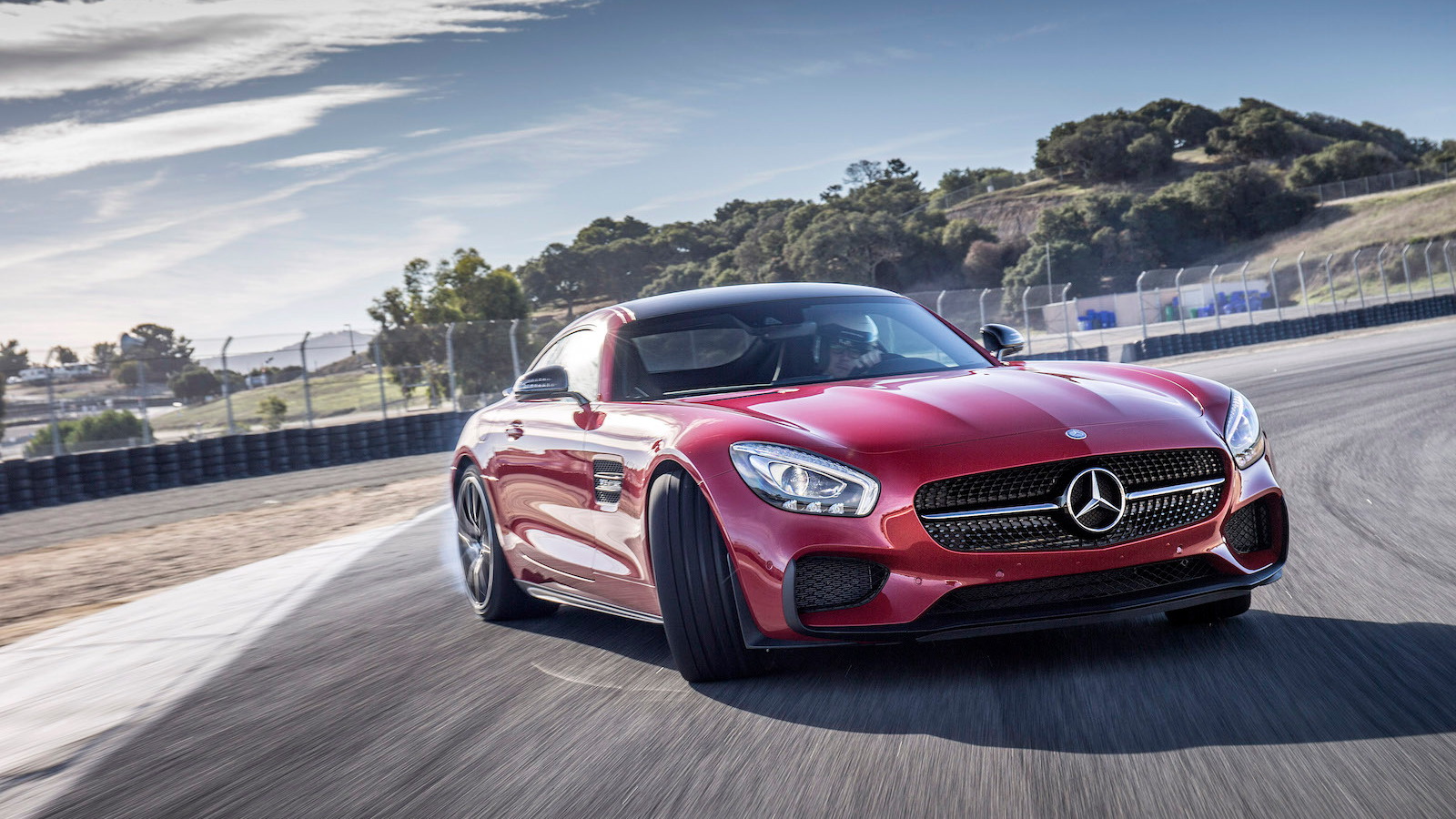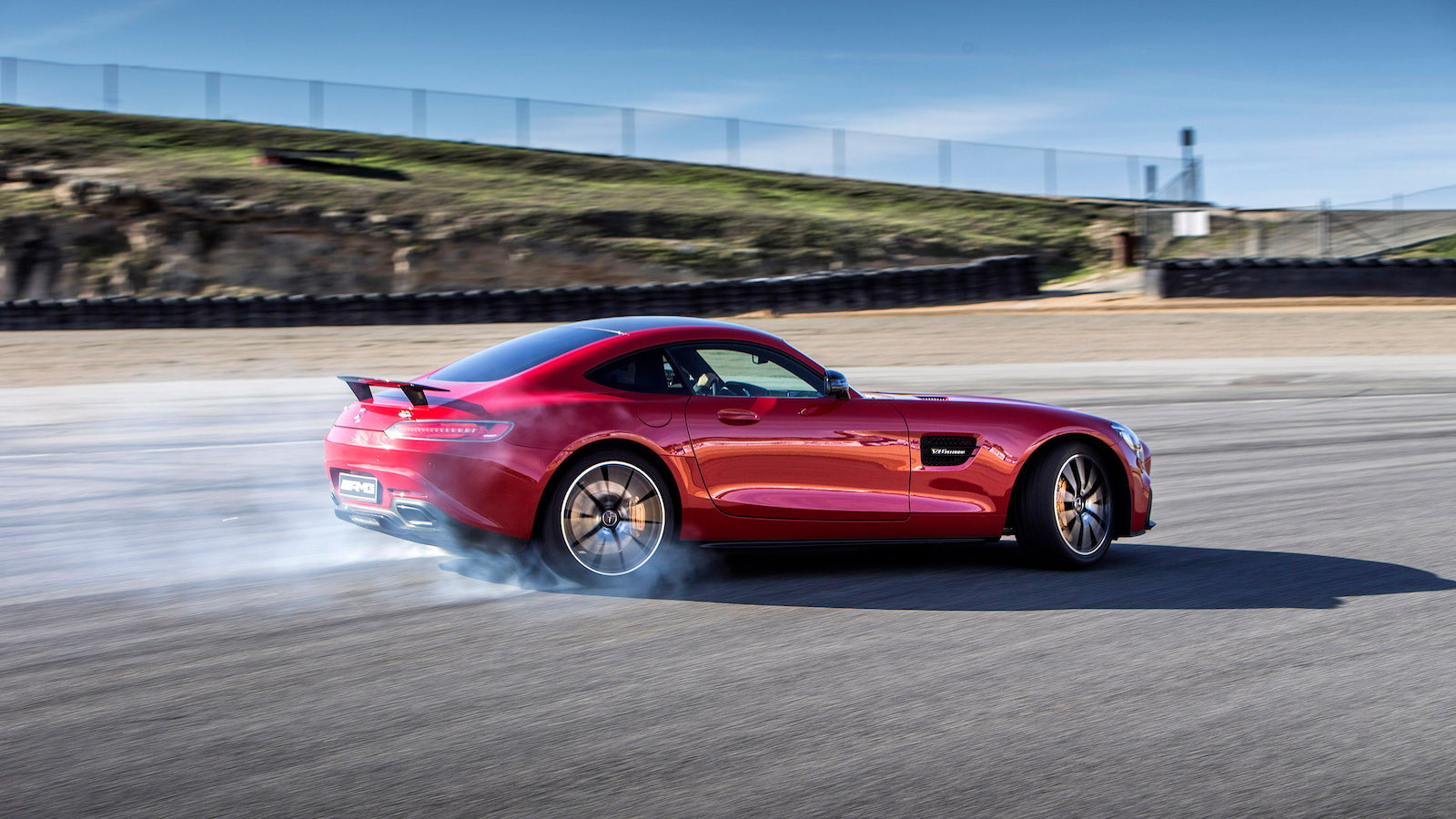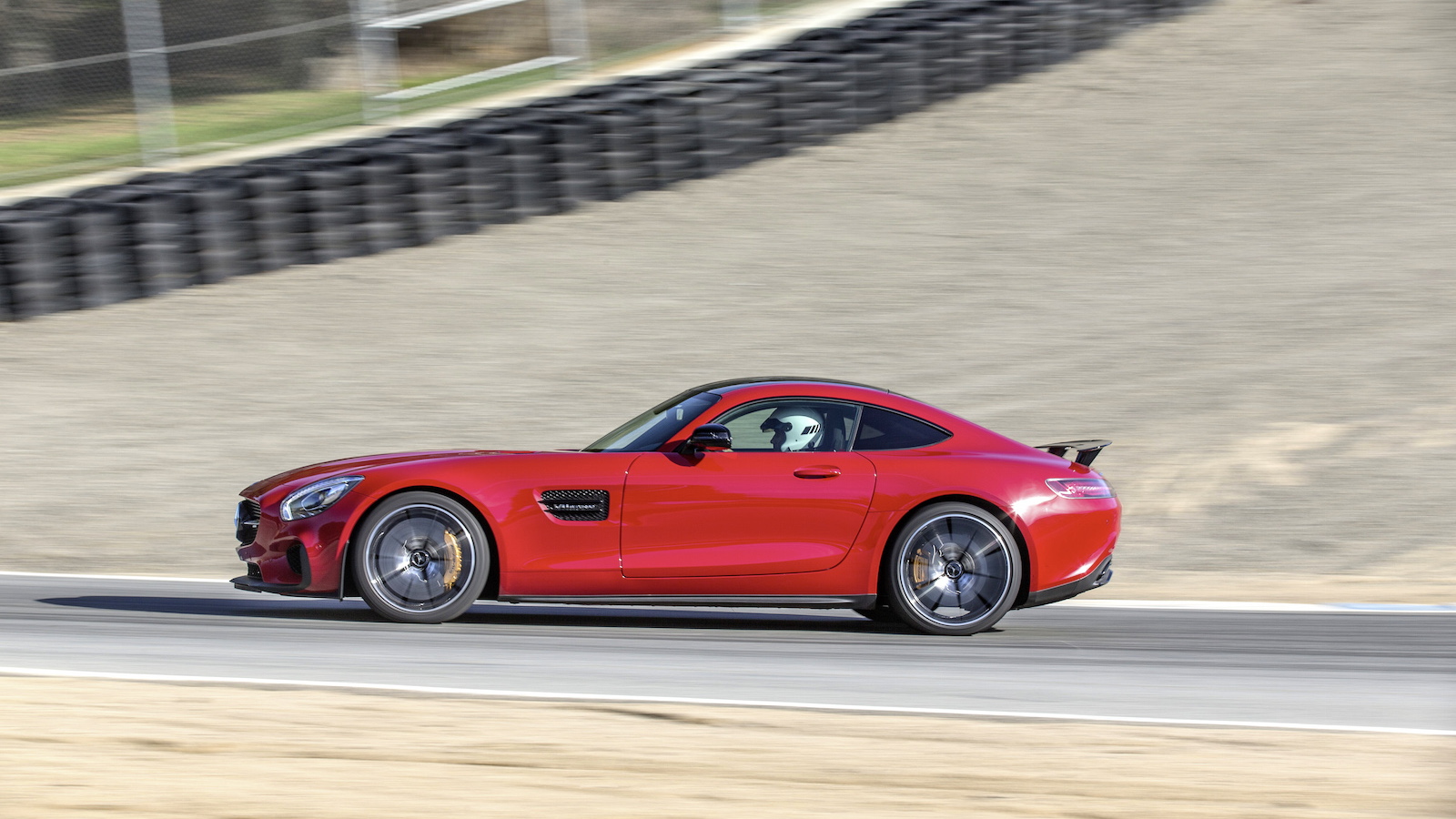It’s rare that a car aimed so squarely at a competitor does so much so differently and yet comes out with a very similar result. The Mercedes-Benz AMG GT S is just such a car.
How so? Well, first of all, from the styling (look at that rear end), to the performance, to the pricing, the AMG GT S is ever-so-clearly intended to take on the benchmark of the GT class, the Porsche 911.
It succeeds.
MUST SEE: 2016 Ford Mustang Shelby GT350 Packs New V-8, Serious Track Upgrades: Video
Utterly different from the 911 in its layout and specification, the AMG GT S nonetheless takes to the road and the track much like its nemesis. It also borrows a lesson or two from the 911’s history, namely: evolution.
Rather than start with a blank sheet for the car that supplants the SLS AMG GT, the team at AMG used much of the previous car’s structure for the AMG GT S (and, coming in 2016, the slightly less powerful AMG GT). The passenger cell is essentially identical, aside from the substitution of normal doors for the previous gullwings; the nose is about 50mm shorter, and the rear end has been tightened up visually, but is functionally the same.
With such a similar starting point, you might think the AMG GT is just a warmed-over version of the SLS. You’d be wrong.
The new engine sits further back, the shorter nose puts the moment of inertia closer to the driver’s centerline, and the improved rear end (especially the electronic locking differential) make for vastly different—and improved—handling characteristics.

2016 Mercedes-Benz AMG GT S at Laguna Seca, first drive, November 2014
Gone is the tendency of the SLS to hang its tail out at every mild provocation. In its place is a supreme level of balance; the driver can steer the AMG GT S with the wheel or the pedals, at will.
Speaking of the steering wheel, the feedback received through its thick-rimmed structure is, quite surprisingly, marvelous. There’s more feel and more feedback than in any electric power steering vehicle we’ve driven, up to and including the Porsche 911 (though it’s about on par with the rather marvelous feel of the 981 Boxster/Cayman duo).
Part of the AMG GT S's charm is owed to the Dynamic Plus package, which includes active engine and differential mounts, which help freeze the pendulum effect of the drivetrain in hard cornering, one of the things which contributed to the oversteer tendencies of the SLS. Thanks to their active status, however, the enhanced mounts don't equate to more noise and vibration in normal driving.
DON'T MISS: It's Time To Watch Ken Block Tear Up L.A. In Gymkhana 7: Video
Also new to the AMG GT S is an extra mode on the AMG Dynamic Select controller, labeled “RACE”. While that might be a bit optimistic for a street car, the gang at AMG aren’t really kidding. Twist the knob until the four-letter word is lit, and the AMG GT S barks to announce its increased bite. The exhaust opens up (thanks to a computer-controlled flap in the system), the engine and transmission tunes get sharper, and the suspension dials in the most aggressive performance. Around Mazda Raceway Laguna Seca, the AMG GT S shines.
On the track
Squeeze the throttle open as you exit turn 11 and head up the front straight, over the crest / kink that is turn 1, pray to the gods of rear-end traction as you chant “neverliftneverliftneverlift”, aim for the telephone pole, squeeze on the brake, ratchet down the gears, trail off brake as you turn in, and the AMG GT S begins to rotate—ever so predictably—allowing you to straighten the wheel as you nudge the first apex, then the second, rolling back to throttle to squirt toward turn 3.
This kind of handling, feel, and athletic grace isn’t something you expect of a 503-horsepower, twin-turbo V-8, roughly 3,500-lb German Autobahn bomber, regardless of the number of doors or drive wheels. It’s certainly not something you expect out of a car with the Tristar on it. But here it is, delivering true sports car feel in a blindingly fast GT package, eagerly and easily.
Rocket out of 3, grabbing fourth. The dual-clutch snicks off its lightning-fast shifts with an exceptionally low amount of request-to-response lag. AMG had to re-engineer the car’s computer system to get that lag time as low as possible, as it was simply taking too long for the electrons to flow through their former route. It’s effort well spent, making the AMG GT S’s gearbox one of the most utterly responsive we’ve ever driven.
Lift, dab a bit of brake, and back to throttle to maintain even balance through turn 4, squeezing back toward 100% as you pass the apex, using just a bit of the curbing on the exit. You’re now lined up perfectly for turn 5, rapidly approaching 130 mph, then on the brakes hard, kicking down a gear, again picking up throttle just before the apex. As you begin to climb the hill toward 6, the slingshot turn under the bridge, you manage line with the throttle, the e-diff applying power with incredible aptitude, Race mode allowing the rear to slide at just a few degrees of speed-gaining yaw. Another quick dab of brake, back to throttle, pop the apex dip at 6, and you’re up the hill, running straight at the top of the corkscrew, grabbing sixth at the last minute. Over the curbing at the left, hard on the brakes, trailing over the crest and more curbing on the right, down two gears to third, a quick left-right, easing back to full throttle as the car grips up at the bottom headed into 9, grabbing fourth along the way.
CHECK OUT: Studio Says Three More Fast And Furious Movies Possible
Ride the center of the tarmac, as the camber works against you out to the right, trail just a touch of brake at turn in to settle the car, over the curb to grab the apex then back on the throttle to slingshot back to the left for 10. Just touching the limiter, you brake hard, riding the bowl of 10’s banking, careful not to the let the car track out to the off-camber outer curb, back up to 5th gear, getting back to the right early for the brake zone to 11, pulling the left paddle twice to set up the exit and get a fast run down the front straight.
That’s a lap at Laguna Seca in the AMG GT, and it’s a thing of beauty. Even with a passel of pudding-brained journalists in tow, the lead-follow laps with DTM champ Bernd Schneider at the front managed to tick by in just 1:41, a scant 8 seconds off the production car lap record (in a Viper TA) recorded by racing driver Randy Pobst in flat-out testing for Motor Trend.
On the road
To truly compete with—let alone beat—the Porsche 911, the AMG GT S must not only excel at the track, it must shine in day-to-day use, as well. While the GT S starts on the back foot here due to its complete lack of a back seat (as opposed to the 911’s vestigial nubs), there’s much to be said for the latest AMG product even in normal highway use.
Switch on the adaptive cruise control, and the GT S handles stop-and-go (or just congested freeway) traffic with the ease of a C Class. Ride quality is certainly more in the sports car vein, but with the drive selector in Comfort mode, it’s pleasant enough even over rough pavement. Wind and road noise are minimal, too, allowing you to hear the Burmester surround sound system all the better.
The seats, however, leave a bit to be desired—at least in standard form. Firm bolsters, an excessively sway-backed lumbar support, and limited range of adjustability (the rear bulkhead limits taller drivers’ recline angle) leaves the seating somewhat awkward, at least for your “sitting dwarf” (a technical German design term meaning long-legged and short-torsoed) author. The story in the passenger seat is worse; the floor board is a few inches closer, forcing my shins into the dashboard if I want a reasonable degree of recline; freeing my legs requires sitting bolt upright with the seat against the bulkhead.
MUST WATCH: Meet The Man That Modified The Cars For 'Furious 7': Video
Optional sport seats remedy many of these problems, though the compact nature of the cabin remains an issue for the longer-legged. For the “sitting giants” like Dieter Zetsche, who personally signs off on each car Daimler’s brands build only after ensuring he can sit comfortably in any position, the seating should offer little or no problem; for those under six feet, proportions won’t matter at all.
This one gripe aside, the AMG GT S proved, over a full day of testing, to be an immensely enjoyable, rewarding car to drive, and one that’s fun to drive not just at race pace, but at a spirited yet sane pace through the winding roads of northern California. Again, the steering reflects more feedback and feel than any modern Mercedes-Benz, and more than nearly any other electric-powered assist system we’ve driven from other brands, too.

2016 Mercedes-Benz AMG GT S
The million dollar question
So, 911 or AMG GT S? It’s too soon to tell. We’ve spent days and weeks in nearly every variant of the 911 currently available. We’ve had only a full day in the GT S.
For a Carrera S competitor, if your focus is on performance above daily utility, and you’d like to have something that doesn’t look like every other car at the office, country club, or Cars & Coffee meet, the AMG GT is a great option.
If you’re eying a 911 Turbo S, on the other hand, the AMG GT, even in GT S trim, may come up a bit short.
So far, however, AMG has come far closer to offering a true 911 competitor than many thought possible—and, in our early estimation, may even have one-upped the benchmark car on a dollar-for-dollar basis, especially when pure driving enjoyment is at the top of the list.

2016 Mercedes-Benz AMG GT S
And yes, there will be a Black Series. We can’t wait to lay hands on that.






